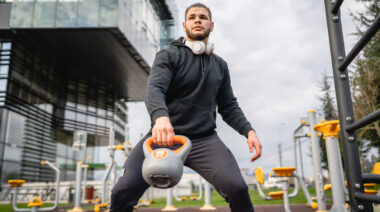There are myriad articles and video on Breaking Muscle (and elsewhere) touting the benefits of the kettlebell swing. I’ve written plenty myself about what a vital role the kettlebell swing plays in developing strength, power, and overall athleticism. This piece is not meant to sell you on the benefits of the swing, or even discuss ad nauseum the intricacies of the movement. No, this piece means to empower you to be your own coach and give you the tools to hone your swing on your own, with help from your smartphone or workout buddy.
While a coach who is well-versed in kettlebell movement and with a keen eye for mechanics will always provide the best guidance, you can develop a fantastic swing with some visual feedback and a focused awareness on creating a few critical sensations.
Begin by recording two short videos of yourself doing a set of kettlebell swings: one from a straight-on view facing the camera, the other from a profile view.
What You Should See From the Front
Stance Width
Stand wide enough to make room for the kettlebell to easily pass between your legs, but not excessively wide. The ideal stance will lead to vertical shins in your bottom/back swing position. If you are too wide, you will forfeit a lot of your power. If you are too narrow (and your knees pass outside of your feet in the bottom position) you also forfeit power and interfere with the relationship between the ground and your feet.
High and Tight Back Swing
As you reach the depth of your back swing, you should see no light between your arms and your body. Hike the bell “high and tight” against your inner thighs as though you are trying to throw it behind you.
Check out the video for a demonstration of these performance points.
What to Learn From the Side View
Viewing your kettlebell swing from the side can teach you almost everything you need to learn about proper swing form.
Flat Back and Neck In-line
Your spine should remain neutral, creating a straight line from your pelvis through your head. Resist the instinctual urge to crane your neck to look forward in the bottom position. Let your head and neck follow along as the chest drops and rises.
Shoulders Above Hips Above Knees
Do not let your shoulders drop below your hips by hinging past horizontal. Women and athletes with flexible hamstrings should be especially wary of this. Do not let your hips sit below your knees, transforming your swing into a squat. A kettlebell swing is a “back and forth” movement (hips through and back), rather than an “up and down” movement like a squat.
Kettlebell Visible Behind on Your Back Swing
Similar to the front view cue to not let any light show between your body and your arms, you should see the bell pop out behind you in your back swing. Keep the bell “high and tight” so that it pops up underneath your butt rather than near your knees.
Vertical Shins
Your shins should remain vertical (and parallel) from the front view, but also roughly vertical from the side view. Keep your knees pulled back and tension in your hamstrings to ensure that your shins are vertical.
Check out the video for demonstration of all these key performance points, and drills to develop and feel them during your swing.






